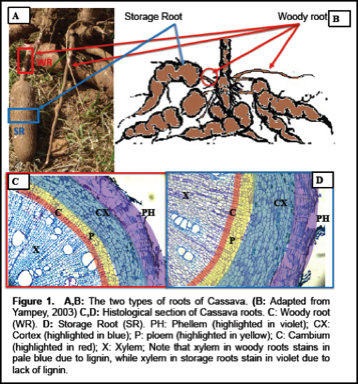CONTACT
GALLERY
TOOLS
PUBLICATIONS
RESEARCH
PEOPLE
Cassava
Research Lines
The team
The aim of this research goal is to generate biotechnology tools to develop new cassava varieties with enhanced agronomic properties for food security.
Cassava in context: new biotechnology efforts to feed sub-Saharan Africa
By 2050 the global population will reach 9.1 billion (34% higher than today), the average global temperature will rise 2-4o C and the arable land surface will undergo a dramatic reduction due to the growth of urban areas (www.fao.org). In such context, the pursuance of biotechnology efforts aimed at improving key crops to guarantee sustainable food security is of paramount importance, especially in those regions that are already food insecure. The root of cassava is the base of the diet for ~ 500 million people in sub-Saharan Africa (www.fao.org). Its ability to accumulate high amounts of starch in its root, grow in many types of soil and resist severe drought and high temperatures conditions converts cassava into the preferred (and in many cases the only) crop for sub-Saharan breeders and self-sustained farmers. The major problems that cassava is currently facing as a crop are:
1. Reduced nutritional value: despite being an outstanding source of carbohydrates, the cassava storage root does not accumulate enough proteins, vitamins or micronutrients to provide a balanced diet.
2. Post-harvest deterioration: roots of cassava tend to degrade severely a few days after collection.
3. Diseases: many of which entail severe symptoms in the root (for example: cassava mosaic virus leads roots to become corky and non-edible).
4. Threatened yield: due to (i) the expected increased demand as a consequence of population growth and (ii) the increasing interest of the bio-ethanol production industry in its high starch content, the availability of cassava biomass for food might be threatened in the mid-term.
Through our work we are generating new biotechnology tools that can provide solid answers to multiple problems in a quick manner.
Agustí
Our selected papers
Identification of MeC3HDZ1/MeCNA as a potential regulator of cassava storage root development
Solé-Gil A, López A, Ombrosi D, Urbez C, Brumós J, Agustí J.
Plant Sci. (2023) 339, 111938.
Vanderschuren H, Agusti J.
Curr. Biol. (2022) 32, 12. PR607-PR609.
Identification and expression analyses of new potential regulators of xylem development and cambium activity in cassava (Manihot esculenta).
Siebers T, Catarino B, Agusti J
Planta (2017) 245, 539-548.

Cassava root development: two root types in one single system
The cassava root system consists mainly on two types of roots that coexist in every individual: the fibrous roots and the storage roots (Fig 1A-B). Once roots have been determined as storage, they initially develop as woody roots, which main function is transporting water and nutrients. At a certain point of development and under certain -yet to be determined- signals, a fraction of the woody roots can develop the storage organ by massively proliferating parenchyma xylem cells that start accumulating starch, becoming, thus, the edible part of the plant. Whether a root remains woody or develops the storage organ depends on the type of secondary xylem that it develops: the woody root produces only xylem fibres and xylem vessels while the storage root produces almost exclusively xylem parenchyma cells, (which, as mentioned above, are the cells that store the starch; Fig 1C-D). Roots that transition from woody to storage undergo a switch in the type of xylem cells that they develop: from fibers and vessels to xylem parenchyma. What are the genetic and molecular mechanisms that (i) control such xylem cell fate switch or (ii) regulate the woody/storage root ratio are questions that still remain unknown. In this conceptual framework, we use cassava as a model system to understand (i) basic and crucial aspects of the genetics and molecular biology of cell fate determination and (ii) how such determination impacts on organ architecture and function. By generating basic knowledge of the cassava root development, we aim at generating new biotechnology tools to generate new cassava varieties with enhanced capacities for storage root formation (and thus, for yield).
Brunot
>
>
CASSAVA

